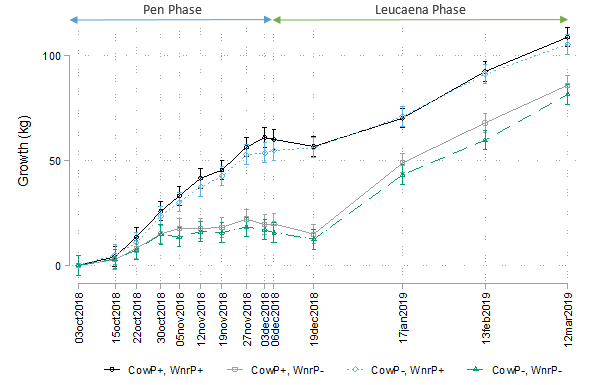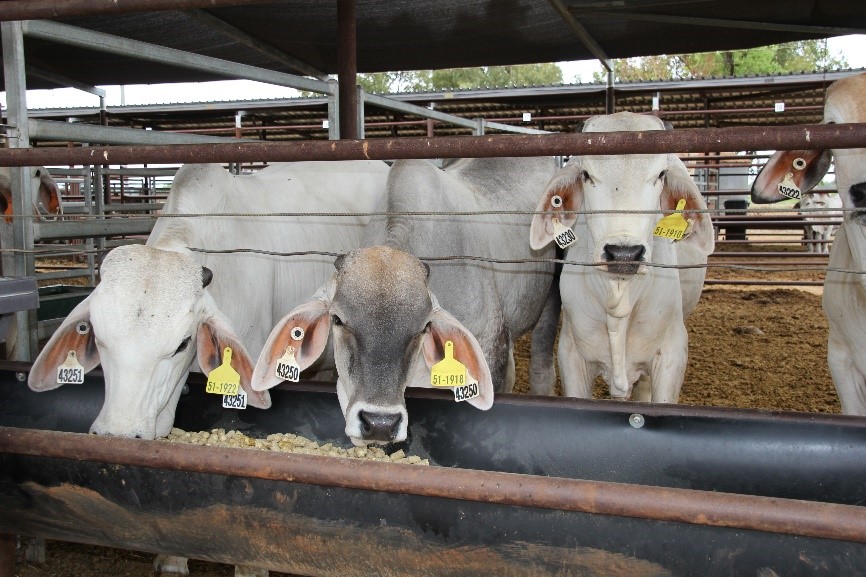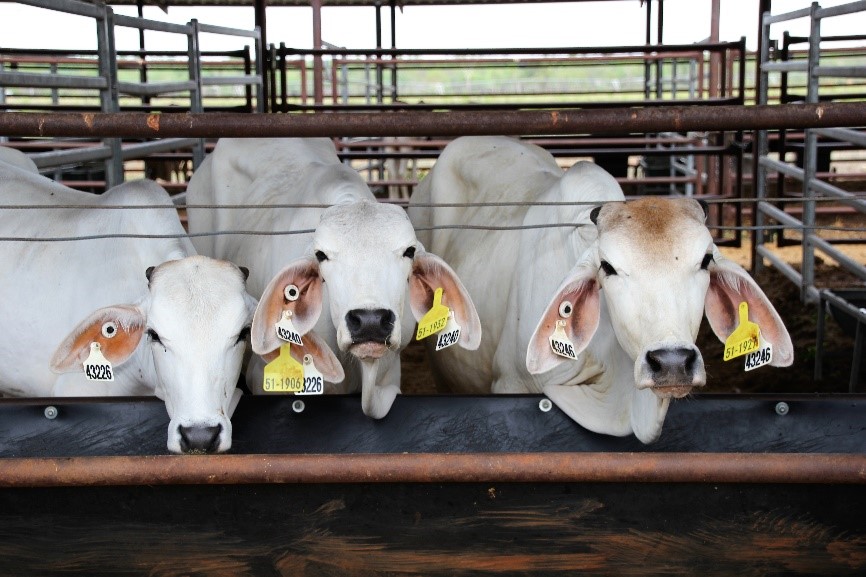Does supplementing cows with phosphorus during pregnancy change weaner performance?
Introduction
Phosphorus (P) often restricts beef production in northern Australia. When an animal’s P demand cannot be met either from the diet or by mobilising body reserves, dietary intake and growth are typically dramatically reduced. Therefore, it is currently recommended that heifers and cows grazing low P areas be supplemented during late pregnancy and while lactating.
A trial currently running on Victoria River Research Station (Kidman Springs) in the Northern Territory (NT) has reported substantial reproduction and productivity gains from P supplementation. Work by Rob Dixon (Queensland Alliance for Agriculture and Food Innovation) and colleagues show that pre-weaning calf growth is also constrained when cows are on low P diets during late pregnancy and lactation.
To investigate post-weaning performance, a pen study was recently conducted at the Katherine Research Station, NT, using progeny from cows that were either supplemented or not supplemented with P during pregnancy and lactation. In this trial the progeny’s growth, while being either being fed high or low P content diets, was recorded.
Method
Four year old Brahman cows grazing P deficient paddocks on Kidman Springs were used to supply the trial weaners. In June 2018 forty-three calves were weaned off cows that received a P supplement during pregnancy and lactation (Cow P+) and thirty calves were weaned from cows with no P supplement (Cow P-).
In September (at 8-10 months of age), after co-grazing native pastures on Kidman Springs, the weaners were relocated to Katherine Research Station and randomly allocated to either a low P (Wnr P-, 0.5 grams P/kg of dry matter) or high P (Wnr P+, 2.8 grams P/kg of dry matter) weaner diet group. Each treatment was replicated three times, with each replicate equal to a pen of two to four animals; the treatment groups were:
- Steers from P- cows, fed P- pellet
- Steers from P- cows, fed P+ pellet
- Steers from P+ cows, fed P- pellet
- Steers from P+ cows, fed P+ pellet
- Heifers from P- cows, fed P- pellet
- Heifers from P- cows, fed P+ pellet
- Heifers from P+ cows, fed P- pellet
- Heifers from P+ cows, fed P+ pellet
The weaners had unlimited access to the experimental pellet for 64 days with their changes in weight measured. Liveweight was recorded after a 15 hour curfew at the start and end of the pen experiment, with interim uncurfewed weights recorded weekly.
On concluding the pen phase of the experiment (6 December 2018), the weaners were relocated to the Douglas Daly Research Farm to graze leucaena-grass pastures at a stocking rate of three animals per hectare. All animals were inoculated with the leucaena rumen bug after grazing the leucaena for about 30 days. Liveweight was recorded monthly after a 12-15 hour curfew to monitor the response of weaners.
Results and discussion
At the beginning of the experiment, weaners from P+ cows were heavier than those from P- cows, with heifers from P+ cows 6.4 kg (174.5 vs. 168.1) heavier and steers 23.9 kg (183.2 vs. 159.3) heavier, when compared to weaners from P- cows. These differences are thought to be explained by P+ cows likely to provide increased milk supply to calves, a response which is explained by increased cow body condition.
While being fed in the pens, growth was associated with diet (P-/P+) with the total growth of weaners on the P+ diet in the pens 40.9 kg greater than the weaners on the P- diet (P<0.001, Figure 1). This effect was independent of cow diet. Or in other words, regardless of cow diet during pregnancy and lactation the performance of weaners was similar when fed either a high and low P diet. This finding was interesting in that despite being similar in age, the calves from P- cows were lower in liveweight at weaning and therefore didn’t appear to display any compensatory gain.
It should also be noted that the growth of weaners on the P- weaner diet appeared to plateau after approximately four weeks of receiving the low P diet.

Over the duration of the project, the average dietary intake of weaners fed P- weaner diet was approximately 1 kg per 100 kg liveweight less than weaners fed the P+ weaner diet (Table 1). The reduced intake of weaners on the P- weaner diet is likely to explain the difference in growth.
Table 1. Average dietary intake of weaners during the pen phase
| Hay intake (kg/100 kg LW) | Pellet intake (kg/100 kg LW) | Diet intake (kg/100 kg LW) | ||||
|---|---|---|---|---|---|---|
| Cow P+ | Cow P- | Cow P+ | Cow P- | Cow P+ | Cow P- | |
| Wnr P+ | 0.26 | 0.30 | 3.0 | 3.1 | 3.3 | 3.4 |
| Wnr P- | 0.31 | 0.39 | 1.8 | 1.8 | 2.1 | 2.2 |
The average daily gain of weaners fed the P- diet during the pen study was approximately 600 grams/day higher than weaners fed the P+ diet during the pen study in the first month after being relocated to the leucaena-pasture grazing system and halved the difference in total growth (ie approximately 20 kg difference). The most likely explanation for the increased growth is the expression of compensatory gain resulting from supressed intake and growth during the pen phase. The average daily gain for all groups was similar in the following two months.
Throughout the trial information on changes in hip height and blood samples for measurement of Plasma Inorganic Phosphorus (PiP) have also been collected and plan to be analysed during 2019.
Take home messages
The preliminary results suggest that the P content of cow diet during pregnancy and lactation influenced initial weaner weight, but had little or no effect on post-weaning performance.
Weaner diets low in P were shown to significantly affect the post-weaning performance of young cattle.
The finding from this study demonstrates the dominating effect of nutrition on weaner performance as well as the chronic impact of weight losses in calves prior to weaning.
Enquiries
For further information, please contact Kieren McCosker, Senior Livestock Scientist, NT Department of Industry Tourism and Trade, phone 08 8973 9771, or email Kieren.McCosker@nt.gov.au.
More resources
- The post-weaning performance of calves from cows with and without access to P during pregnancy and lactation – Paper 235, page 70 in the Proceedings of the Northern Beef Research Update Conference 2019.

